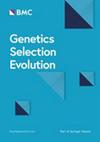Predicted breeding values for relative scrapie susceptibility for genotyped and ungenotyped sheep
IF 3.1
1区 农林科学
Q1 AGRICULTURE, DAIRY & ANIMAL SCIENCE
引用次数: 0
Abstract
Scrapie is an infectious prion disease in sheep. Selective breeding for resistant genotypes of the prion protein gene (PRNP) is an effective way to prevent scrapie outbreaks. Genotyping all selection candidates in a population is expensive but existing pedigree records can help infer the probabilities of genotypes in relatives of genotyped animals. We used linear models to predict allele content for the various PRNP alleles found in Icelandic sheep and compiled the available estimates of relative scrapie susceptibility (RSS) associated with PRNP genotypes from the literature. Using the predicted allele content and the genotypic RSS we calculated estimated breeding values (EBV) for RSS. We tested the predictions on simulated data under different scenarios that varied in the proportion of genotyped sheep, genotyping strategy, pedigree recording accuracy, genotyping error rates and assumed heritability of allele content. Prediction of allele content for rare alleles was less successful than for alleles with moderate frequencies. The accuracy of allele content and RSS EBV predictions was not affected by the assumed heritability, but the dispersion of prediction was affected. In a scenario where 40% of rams were genotyped and no errors in genotyping or recorded pedigree, the accuracy of RSS EBV for ungenotyped selection candidates was 0.49. If only 20% of rams were genotyped, or rams and ewes were genotyped randomly, or there were 10% pedigree errors, or there were 2% genotyping errors, the accuracy decreased by 0.07, 0.08, 0.03 and 0.04, respectively. With empirical data, the accuracy of RSS EBV for ungenotyped sheep was 0.46–0.65. A linear model for predicting allele content for the PRNP gene, combined with estimates of relative susceptibility associated with PRNP genotypes, can provide RSS EBV for scrapie resistance for ungenotyped selection candidates with accuracy up to 0.65. These RSS EBV can complement selection strategies based on PRNP genotypes, especially in populations where resistant genotypes are rare.基因型羊和非基因型羊相对痒病易感性的预测育种值
痒病是绵羊的传染性朊病毒疾病。朊蛋白基因(PRNP)抗性基因型的选择性选育是预防痒病暴发的有效途径。对种群中所有选择候选者进行基因分型是昂贵的,但现有的家谱记录可以帮助推断基因分型动物亲属的基因分型概率。我们使用线性模型预测在冰岛羊中发现的各种PRNP等位基因的等位基因含量,并从文献中编译了与PRNP基因型相关的相对痒病易感性(RSS)的可用估计。利用预测的等位基因含量和基因型RSS计算了RSS的估计育种值(EBV)。在基因型羊比例、基因分型策略、家谱记录准确性、基因分型错误率和等位基因含量的假设遗传力等不同情景下,利用模拟数据对预测结果进行检验。对罕见等位基因含量的预测不如中等频率等位基因的预测成功。等位基因含量和RSS EBV预测的准确性不受假设遗传力的影响,但预测的分散性受到影响。在40%的公羊进行基因分型,且没有基因分型错误或家谱记录错误的情况下,RSS EBV对非基因分型选择候选羊的准确性为0.49。当只对20%的公羊进行基因分型、公羊和母羊随机分型、家系误差为10%、基因分型误差为2%时,准确率分别降低0.07、0.08、0.03和0.04。实验数据表明,非基因分型绵羊的RSS EBV检测精度为0.46 ~ 0.65。预测PRNP基因等位基因含量的线性模型,结合与PRNP基因型相关的相对易感性估计,可以为非基因型选择候选人提供瘙痒病抗性的RSS EBV,准确率高达0.65。这些RSS EBV可以补充基于PRNP基因型的选择策略,特别是在耐药基因型罕见的人群中。
本文章由计算机程序翻译,如有差异,请以英文原文为准。
求助全文
约1分钟内获得全文
求助全文
来源期刊

Genetics Selection Evolution
生物-奶制品与动物科学
CiteScore
6.50
自引率
9.80%
发文量
74
审稿时长
1 months
期刊介绍:
Genetics Selection Evolution invites basic, applied and methodological content that will aid the current understanding and the utilization of genetic variability in domestic animal species. Although the focus is on domestic animal species, research on other species is invited if it contributes to the understanding of the use of genetic variability in domestic animals. Genetics Selection Evolution publishes results from all levels of study, from the gene to the quantitative trait, from the individual to the population, the breed or the species. Contributions concerning both the biological approach, from molecular genetics to quantitative genetics, as well as the mathematical approach, from population genetics to statistics, are welcome. Specific areas of interest include but are not limited to: gene and QTL identification, mapping and characterization, analysis of new phenotypes, high-throughput SNP data analysis, functional genomics, cytogenetics, genetic diversity of populations and breeds, genetic evaluation, applied and experimental selection, genomic selection, selection efficiency, and statistical methodology for the genetic analysis of phenotypes with quantitative and mixed inheritance.
 求助内容:
求助内容: 应助结果提醒方式:
应助结果提醒方式:


